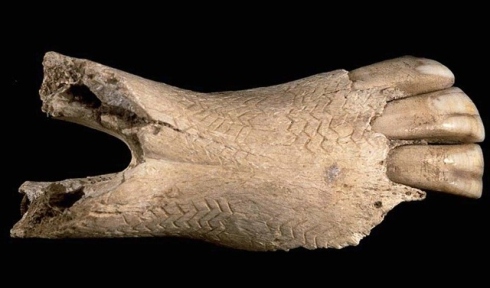The decorated horse jawbone fragment from Kendrick’s Cave, Wales (BM 1959,1203.1)
Colour holography of the oldest known work of art from Wales by Hans Bjelkhagen and Jill Cook.
Dated as about 14000 years old, the jawbone of a horse decorated with zigzag patterns from Kendrick’s Cave, near Llandudno in North Wales, is the oldest known work of art from Wales. While it was on loan to Llandudno Museum as part of the British Museum’s UK Partnership Programme, the opportunity arose to reproduce it as a hologram using the most accurate currently available imaging technology. This contribution describes how the jaw fragment was reproduced using the latest techniques in three-dimensional colour holography, developed at the Centre for Modern Optics (OpTIC) at Glyndŵr University, St Asaph.
INTRODUCTION
The Kendrick’s Cave horse jawbone
In 1880 the lapidary Thomas Kendrick found a decorated chin fragment from a horse jawbone in a cave on Great Orme, Llandudno, Wales which was then named after him. The bone has a pattern of incised zig-zag lines on the underside and is the oldest work of art known from Wales. Dated to about 14000 years old it is one of only a small number of decorated Late Ice Age objects found in Britain. After Kendrick’s death the object disappeared but came to light again in London in 1959 when a new owner brought it into the British Museum and it was identified as the missing piece from the cave. As there was no museum service in Llandudno at that time, the British Museum acquired the object and it has been on permanent display ever since.
From Volume Four in the British Museum’s Technical Research Bulletin series.




Leave a comment
Comments feed for this article